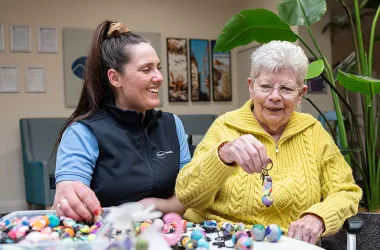Wayfinding solutions for better living
8th February 2023 | 3 min read
What is Wayfinding?
Wayfinding refers to the practice of using spatial information to help people navigate a physical space. This is particularly important in aged care settings. Making it easy for residents to find their way around helps them to settle in more easily and feel secure in their surroundings, contributing to a better quality of life.
At Opal HealthCare we incorporate accessible design and functionality into the design and build of new Care Communities, and a program of work updating older Care Communities is underway to enhance the resident experience. Wayfinding problems can cause anxiety, distress, and decreased interaction among people living with dementia. Visual cues are an effective intervention to help ageing people find their way more easily.
Importance of accessibility for safety and inclusion
As we age, we become more likely to develop conditions that may impact our independence and the way we participate in society. For Opal HealthCare, creating accessible places means more than just complying with minimum building standards or legal requirements. It means continually challenging ourselves to optimise our physical environments to meet the individual needs of residents and improve quality of life.
Disabling factors that can make navigating through spaces challenging for people include:
- Diminishing sight (colour and clarity)
- Forgetfulness or confusion
- Physical impairment
- Cognitive decline
The impact of the physical environment on quality of life
Improving accessibility enables higher quality care delivery and a better experience living in care. It enables residents to be more independent and autonomous, feel safer in their surroundings and more confident in the activities of daily life. All of these factors contribute to living with dignity and respect.
We incorporate numerous factors into wayfinding design, including the use of colour, furniture design and placement, lighting, and the way signage and lettering is presented. All are intended to create a more comfortable living experience and a better quality of life in care.
We are progressively updating internal signage across our Care Communities to optimise the resident experience.
- Colours that create contrast between the floor, walls, ceiling, furniture and doorways are chosen to help residents with vision impairment differentiate space. Residents with cognitive impairment are more able to recognise and identify different areas and navigate their way around.
- Lighting is installed at a distance and strength that minimises glare and darker spots in a space, to create the best visual conditions for residents with vision impairments. In shared and bedroom spaces, warm tone lighting is used to create a relaxing mood and can soften the appearance of skin blemishes, so that residents feel comfortable and at ease. In bathrooms and clinical spaces, white lighting is used to maximise visual clarity which helps our team identify health conditions and provide appropriate care in privacy.
- We recognise that one size doesn’t fit all, so we work with physiotherapists to choose furniture that accommodates diverse physical requirements and incorporates contrasting colours between the seat base and surroundings. When a resident can easily identify a chair in a room full of different visual elements, it helps them to more confidently and autonomously navigate to the chair and use it.
- Fonts and symbols are chosen for accessibility. Simple fonts with contrasting background and symbols are effective in helping residents with cognitive and vision impairment read more clearly, identity, remember and differentiate spaces.
Impact:
- A safe environment for residents, families and team, particularly those with vision and cognitive impairments
- Improves belonging and self-confidence
- Greater social inclusion
- Increases autonomy and independence
- Decreased reports of intrusions into bedrooms by other residents
- Greater satisfaction for residents and families
More from our Care Communities

News & Events
Highgate Park update
19th December 2025 | 2 min read

Care Community stories
Sicilian connections at Glenroy Grove
16th December 2025 | 4 min read

Care Community stories
Purpose with Parkinson's Disease
12th December 2025 | 4 min read